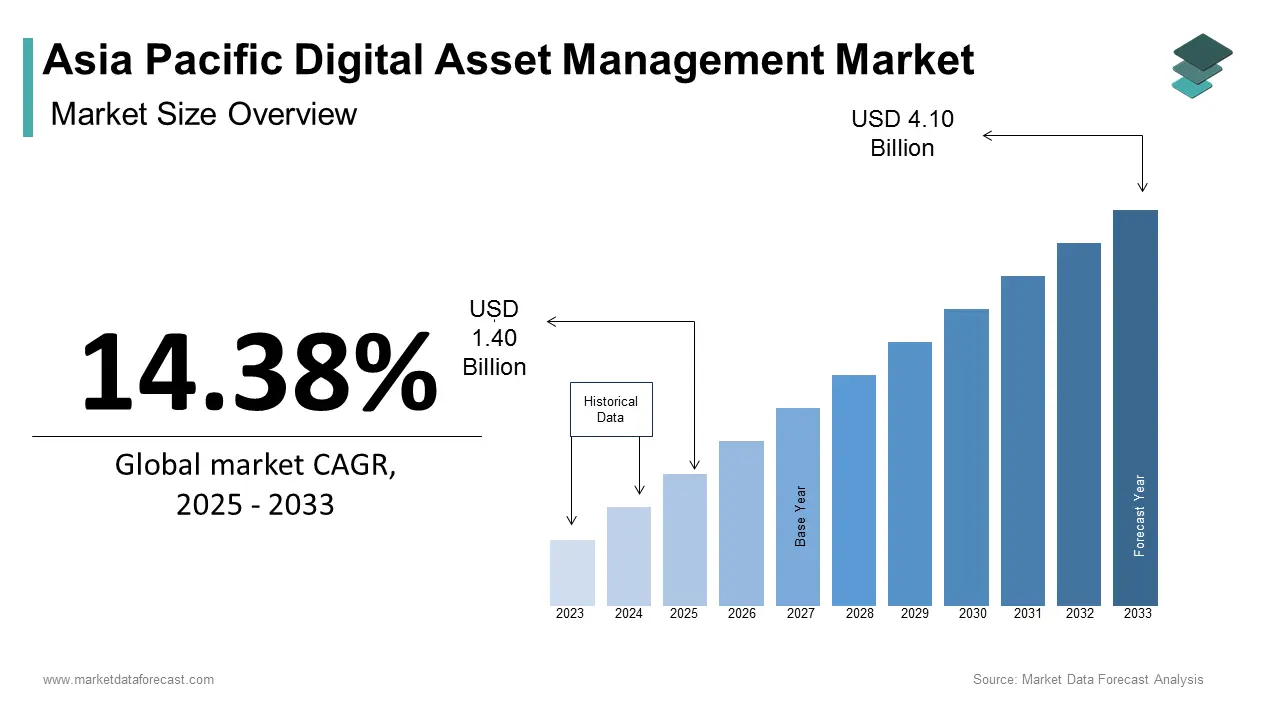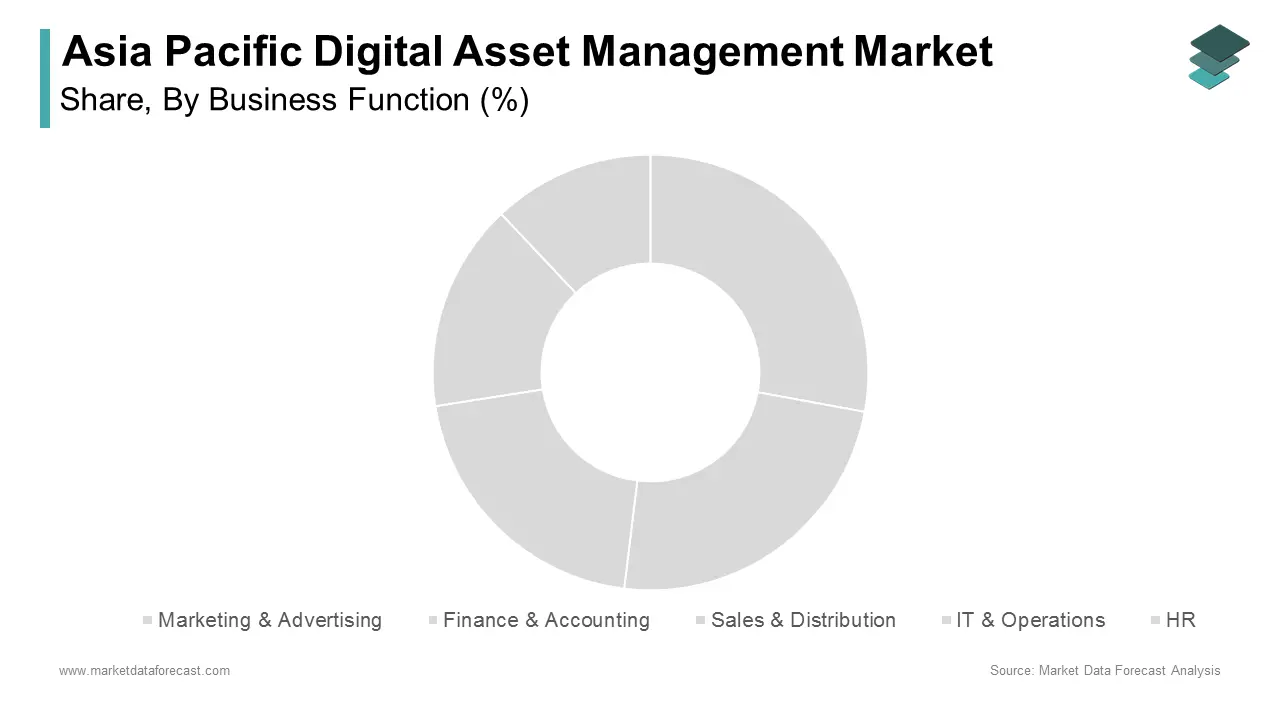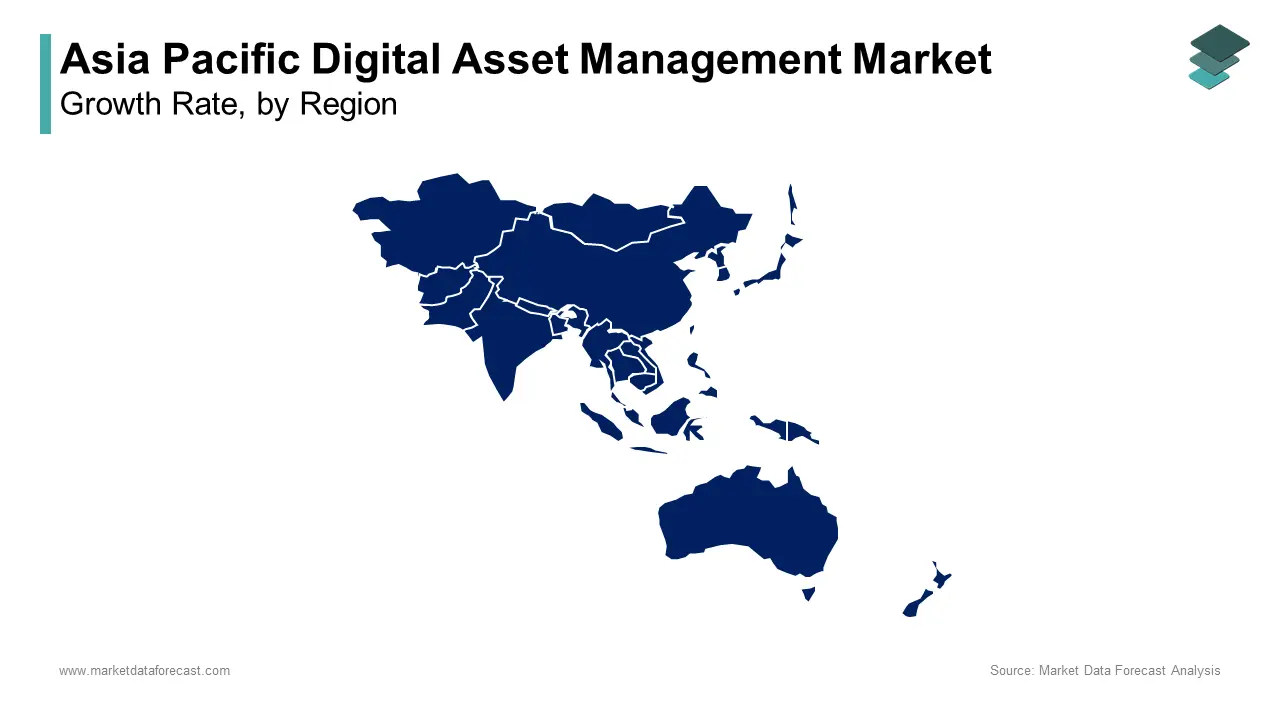Asia Pacific Digital Asset Management Market Size, Share, Trends & Growth Forecast Report By Business function (Marketing & Advertising, Finance & Accounting, Sales & Distribution, IT & Operations, HR), Solutions, Vertical, And Country (India, China, Japan, South Korea, Australia, New Zealand, Thailand, Malaysia, Vietnam, Philippines, Indonesia, Singapore And Rest of Asia-Pacific), Industry Analysis From 2025 To 2033
Asia Pacific Digital Asset Management Market Size
The Asia Pacific digital asset management market size was calculated to be USD 1.22 billion in 2024 and is anticipated to be worth USD 4.10 billion by 2033, from USD 1.40 billion in 2025, growing at a CAGR of 14.38% during the forecast period.

The Asia Pacific digital asset management (DAM) market has emerged as a critical enabler of digital transformation, driven by the exponential growth of digital content and the need for efficient asset organization. Government initiatives promoting digital literacy further accelerate adoption. The investments in digital infrastructure across the region are expected to exceed $1 trillion by 2030 by enhancing accessibility for businesses.
MARKET DRIVERS
Rising Demand for Centralized Content Management
The increasing demand for centralized content management serves as a primary driver for the Asia Pacific DAM market, fueled by the proliferation of digital content across industries. For example, South Korea’s gaming industry, valued at over $10 billion annually, utilizes DAM platforms to manage game assets and streamline development workflows. Government support further amplifies this trend. As per the Ministry of Electronics and Information Technology in India, subsidies for digital infrastructure have increased by 25% since 2020 by ensuring widespread adoption. Additionally, sectors like retail and healthcare rely on DAM systems for personalized customer experiences by driving demand for scalable solutions.
Growth of E-commerce Platforms
The rapid expansion of e-commerce platforms is another critical driver propelling the Asia Pacific DAM market. For instance, China’s Alibaba and JD.com invest heavily in DAM solutions to enhance customer acquisition and retention through personalized recommendations. The rise of social commerce further amplifies adoption. Additionally, sectors like fashion and electronics utilize DAM platforms to deliver immersive brand experiences by enhancing user engagement.
MARKET RESTRAINTS
Data Security Concerns
Data security concerns pose significant restraints to the Asia Pacific DAM market by undermining trust and hindering adoption among enterprises. For instance, China’s stringent Cybersecurity Law mandates that critical data be stored locally, complicating operations for multinational firms reliant on global DAM platforms. Similarly, India’s Personal Data Protection Bill imposes strict regulations on cross-border data transfers by limiting flexibility for DAM providers. Moreover, high-profile data breaches exacerbate the issue. While larger corporations can invest in advanced encryption and threat detection systems, smaller players often lack the resources to mitigate risks effectively.
Integration Challenges with Legacy Systems
Integration challenges with legacy systems present another major restraint for the Asia Pacific DAM market, particularly for organizations seeking to transition from traditional content management tools. This complexity is particularly pronounced in emerging economies like Vietnam and Indonesia, where technological readiness remains a key concern. Additionally, the need for specialized skills to manage DAM systems compounds the issue. To address this challenge, stakeholders must invest heavily in training and after-sales support. The market risks stagnation and was unable to fully leverage its growth potential amidst escalating demand.
MARKET OPPORTUNITIES
Adoption of AI-Driven DAM Solutions
The adoption of AI-driven DAM solutions presents a transformative opportunity for the Asia Pacific DAM market by enabling businesses to automate asset tagging, metadata generation, and content discovery. According to PwC, AI-powered DAM platforms are projected to reduce content management costs by up to 30% by driving adoption among cost-conscious enterprises. For instance, Japan’s automotive sector utilizes AI-driven DAM systems to manage product documentation and marketing assets by enhancing efficiency and scalability. China, a leader in digital innovation, is spearheading the adoption of AI-driven DAM solutions in e-commerce. Additionally, sectors like healthcare and manufacturing utilize predictive analytics to deliver personalized content, which is driving demand for scalable technologies.
Rising Investments in Cloud-Based DAM Platforms
Rising investments in cloud-based DAM platforms offer significant growth avenues for the Asia Pacific DAM market, driven by the region’s focus on scalability and accessibility. For example, India’s media and entertainment sector leverages cloud-based DAM solutions to manage video assets and enhance collaboration, driving regional demand. Similarly, the proliferation of hybrid work models amplifies adoption. Additionally, sectors like education and government rely on cloud platforms to ensure secure and efficient asset management.
MARKET CHALLENGES
Intense Market Competition
Intense market competition poses a formidable challenge for the Asia Pacific DAM market, characterized by the presence of numerous domestic and international players vying for dominance. This overcrowded landscape results in price wars, eroding profit margins and straining smaller players. For instance, global providers like Adobe and Widen dominate the market with cost-effective offerings by leveraging economies of scale to undercut competitors.
India and Southeast Asia witness similar dynamics, where local players struggle to compete with established brands. A study by the Confederation of Indian Industry reveals that price sensitivity among buyers exacerbates the issue, with 60% of customers prioritizing cost over quality. Additionally, the lack of product differentiation limits growth opportunities by forcing companies to focus on aggressive marketing strategies rather than innovation. Intellectual property disputes further complicate the scenario, as per the World Intellectual Property Organization, with allegations of design infringements being common. These competitive pressures hinder profitability and stifle technological advancements by challenging manufacturers to strike a balance between affordability and innovation to remain relevant in the market.
Skilled Labor Shortages
Skilled labor shortages represent another pressing challenge for the Asia Pacific DAM market with operational efficiency and hindering growth. According to the International Labour Organization, the digital content management sector faces a deficit of skilled professionals in emerging economies like India and Indonesia. For instance, a survey by the Associated Chambers of Commerce and Industry of India reveals that nearly 40% of DAM implementations experience delays due to a lack of trained personnel. Furthermore, the complexity of modern DAM systems requires specialized training, which is often inaccessible to workers in rural areas. This scarcity not only impacts project timelines but also increases operational risks, as untrained personnel are more prone to errors. To address this challenge, industry stakeholders must collaborate with educational institutions and government bodies to establish comprehensive training initiatives.
REPORT COVERAGE
|
REPORT METRIC |
DETAILS |
|
Market Size Available |
2024 to 2033 |
|
Base Year |
2024 |
|
Forecast Period |
2025 to 2033 |
|
CAGR |
14.38% |
|
Segments Covered |
By Business function, Solutions, Vertical, And Region |
|
Various Analyses Covered |
Global, Regional & Country Level Analysis; Segment-Level Analysis; DROC, PESTLE Analysis; Porter’s Five Forces Analysis; Competitive Landscape; Analyst Overview of Investment Opportunities |
|
Regions Covered |
India, China, Japan, South Korea, Australia, New Zealand, Thailand, Malaysia, Vietnam, Philippines, Indonesia, Singapore, Rest of Asia-Pacific |
|
Market Leaders Profiled |
Adobe Systems, OpenText Corporation, Oracle Corporation, Bynder, MediaBeacon, Widen Enterprises, Cognizant, Celum, Cloudinary, Aprimo, Brandfolder, Northplains Systems |
SEGMENTAL ANALYSIS
By Business Function Insights

The marketing & advertising segment was the largest by capturing 40.3% of share in 2024 with region’s focus on delivering personalized and engaging content to consumers across digital platforms. Government initiatives further amplify this trend. Additionally, sectors like retail and entertainment utilize DAM platforms to deliver immersive brand experiences with demand for scalable solutions. This growth is fueled by the increasing need for centralized content management systems to support enterprise-wide digital transformation initiatives. For example, Japan’s manufacturing sector utilizes DAM platforms to manage technical documentation and streamline operational workflows by enhancing efficiency and scalability. The rise of hybrid work models further amplifies adoption. Additionally, industries like healthcare and education rely on DAM platforms to ensure secure and efficient asset management by driving demand for innovative technologies.
By Solutions Insights
The cloud-based solutions segment was the largest by occupying prominent share of the Asia Pacific DAM market in 2024 due to their affordability, scalability, and accessibility by making them ideal for enterprises seeking cost-effective DAM platforms. For instance, India’s media and entertainment sector leverages cloud-based DAM solutions to manage video assets and enhance collaboration. Government support further amplifies this trend. Additionally, sectors like e-commerce and retail rely on cloud platforms to ensure secure and efficient asset management by driving demand for scalable technologies.
The on-premises solutions segment is likely to experience a CAGR of 12.3% in the next coming years. This growth is fueled by stringent data localization laws and the need for enhanced security measures, particularly in industries like BFSI and government. For example, South Korea’s financial sector utilizes on-premises DAM systems to comply with local regulations. The proliferation of sensitive data further amplifies adoption. Over 70% of enterprises in the region cite data security as a major concern by necessitating localized storage solutions. Additionally, sectors like healthcare and defense rely on on-premises platforms to ensure compliance with strict regulatory frameworks are driving demand for specialized technologies.
By Vertical Insights
The retail dominated the Asia Pacific DAM market with 35.4% market share. This dominance is driven by the region’s rapid e-commerce growth and the need for efficient content management systems to handle vast product catalogs and multimedia assets. For instance, China’s Alibaba and JD.com invest heavily in DAM platforms to deliver personalized recommendations, driving regional demand. Government initiatives further amplify this trend. Additionally, sectors like fashion and electronics utilize DAM systems to deliver immersive brand experiences by driving demand for scalable technologies.
The manufacturing segment is anticipated to exhibit a CAGR of 14.5% in the coming years. This growth is fueled by the increasing adoption of Industry 4.0 technologies, which necessitate centralized content management systems to support digital transformation initiatives. For example, Japan’s automotive sector utilizes DAM platforms to manage product documentation and streamline development workflows by enhancing efficiency and scalability. The rise of smart factories further amplifies adoption. Additionally, sectors like aerospace and electronics rely on DAM platforms to ensure secure and efficient handling of technical assets, driving demand for innovative technologies.
REGIONAL ANALYSIS

China was the largest contributor for Asia Pacific DAM market with 40.3% of share in 2024 due to its massive digital economy and stringent localization laws. For instance, China’s Cybersecurity Law mandates that critical data be stored locally by creating robust demand for domestic DAM platforms like Alibaba Cloud. Additionally, the proliferation of e-commerce drives adoption, with over 40% of global online sales originating from the region. Government support further amplifies growth.
India's DAM market held a 20.3% share in 2024 with the rapid digitalization and startup ecosystem drive demand for scalable DAM solutions. According to the Ministry of Electronics and Information Technology, investments in digital infrastructure have increased by 25% since 2020 by encouraging businesses to adopt DAM platforms. The proliferation of affordable smartphones further amplifies adoption. For instance, Flipkart and Amazon India rely heavily on DAM systems to manage consumer data by reducing operational costs. Additionally, partnerships with domestic providers like Tata Consultancy Services bolster supply chain resilience.
Japan digital assest management market growth is driven by it’s expertise in advanced technologies in sectors like automotive and electronics manufacturing. For instance, Toyota and Sony utilize DAM platforms extensively in production lines by enhancing precision and energy efficiency.
Government initiatives play a pivotal role. According to the Ministry of Economy, Trade, and Industry, Japan plans to invest $5 billion in sustainable manufacturing by 2025 by focusing on eco-friendly technologies. Collaborations with global players like IBM ensure access to cutting-edge systems. These initiatives position Japan as a key contributor to the regional market.
South Korea digital asset management market growth is driven by its dominance in the gaming and entertainment sectors. For example, Nexon and NCSoft rely heavily on DAM systems for delivering seamless online experiences, driving regional demand. Government support further amplifies growth. Collaborations with domestic players like Naver Cloud bolster supply chain resilience.
Australian and New Zealand DAM market is driven by its focus on sustainability and renewable energy projects. Government initiatives further amplify growth. According to the Department of Industry, Science, and Resources, subsidies for green energy projects have increased by 20% since 2020 by encouraging the adoption of energy-efficient technologies. Collaborations with global players like Google Cloud ensure access to cutting-edge systems.
LEADING PLAYERS IN THE ASIA PACIFIC DIGITAL ASSET MANAGEMENT MARKET
Adobe Systems
Adobe Systems is a dominant player in the Asia Pacific DAM market, renowned for its robust and scalable solutions tailored to enterprise needs. The company’s Adobe Experience Manager (AEM) platform enables businesses to organize, manage, and deliver digital assets seamlessly across multiple channels. Recently, Adobe expanded its AI-driven capabilities in India, enhancing asset tagging and metadata generation for media companies. Additionally, partnerships with e-commerce firms like Flipkart ensure the adoption of its platforms for personalized customer experiences.
Widen Enterprises
Widen Enterprises plays a pivotal role in the Asia Pacific DAM market by offering user-friendly and cost-effective solutions for mid-sized enterprises. Its Widen Collective platform is widely adopted by industries like retail and manufacturing for centralized content management. Recently, Widen introduced advanced analytics tools in South Korea, enabling brands to measure asset performance and optimize marketing campaigns. Collaborations with local agencies further solidify its position.
OpenText Corporation
OpenText Corporation is a key force in the Asia Pacific DAM market, particularly in sectors like BFSI and government, where data security and compliance are critical. Its OpenText Media Management solution enables organizations to manage multimedia assets efficiently while ensuring regulatory adherence. Recently, OpenText partnered with financial institutions in Japan to deploy on-premises DAM systems, aligning with local data localization laws. The company also expanded its cloud offerings in Australia, targeting SMEs with scalable solutions.
TOP STRATEGIES USED BY KEY MARKET PARTICIPANTS
Key players in the Asia Pacific DAM market employ diverse strategies to maintain their competitive edge. Innovation and R&D investments rank among the most prominent approaches, with companies developing AI-driven and cloud-based solutions. Strategic partnerships and collaborations are also widely adopted, enabling firms to tap into emerging markets and secure contracts for large-scale projects. Localization efforts, such as creating region-specific features, reduce barriers and improve accessibility. Sustainability-focused measures, such as developing eco-friendly platforms, further strengthen market positioning.
KEY MARKET PLAYERS AND COMPETITION OVERVIEW
Major players of the Asia Pacific DAM Market include Adobe Systems, OpenText Corporation, Oracle Corporation, Bynder, MediaBeacon, Widen Enterprises, Cognizant, Celum, Cloudinary, Aprimo, Brandfolder, Northplains Systems
The Asia Pacific DAM market is characterized by intense competition, which was driven by the presence of global giants and regional players vying for dominance. Established companies like Adobe, Widen, and OpenText leverage their technological expertise and extensive distribution networks to maintain its dominance. Meanwhile, local manufacturers compete aggressively on pricing, offering cost-effective solutions tailored to budget-conscious customers. The market’s competitive landscape is further shaped by rapid technological advancements and government initiatives aimed at boosting digital infrastructure. To differentiate themselves, players focus on innovation, introducing cutting-edge products for AI, cloud integration, and analytics. Sustainability initiatives, such as low-emission data centers, are also gaining traction amid stricter environmental regulations.
RECENT HAPPENINGS IN THE MARKET
- In March 2023, Adobe Systems launched AI-driven asset tagging tools in India by enabling media companies to streamline content management and enhance efficiency.
- In May 2023, Widen Enterprises introduced advanced analytics features in South Korea by allowing brands to measure asset performance and optimize marketing campaigns.
- In July 2023, OpenText Corporation partnered with Japanese financial institutions to deploy on-premises DAM systems by ensuring compliance with local data localization laws.
- In September 2023, Cloudinary expanded its cloud-based DAM offerings in Australia, which is targeting SMEs with scalable and affordable solutions.
- In November 2023, Bynder collaborated with e-commerce firms in Southeast Asia to offer localized DAM platforms by enhancing accessibility for regional advertisers.
MARKET SEGMENTATION
This research report on the Asia Pacific digital asset management market has been segmented and sub-segmented based on business function, solutions, vertical, and region.
By Business function
- Marketing & Advertising
- Finance & Accounting
- Sales & Distribution
- IT & Operations
- HR
By Solutions
- On-premises
- Cloud
By Vertical
- BFSI
- Retail
- Government
- Manufacturing
By Region
- India
- China
- Japan
- South Korea
- Australia
- New Zealand
- Thailand
- Malaysia
- Vietnam
- Philippines
- Indonesia
- Singapore
- Rest of Asia-Pacific
Frequently Asked Questions
1. What is driving the growth of the DAM market in Asia Pacific?
Key growth drivers include increased digital content creation, growing adoption of cloud-based solutions, rising marketing automation, and demand for brand consistency across channels.
2. Who are the major players in the Asia Pacific DAM market?
Leading companies include Adobe Systems, OpenText Corporation, Oracle Corporation, Bynder, Widen Enterprises, MediaBeacon, Brandfolder, and Aprimo.
3. Which industries are the top users of DAM solutions in the region?
Media & entertainment, retail & e-commerce, BFSI, healthcare, and manufacturing sectors are major adopters of DAM tools.
4. How does DAM help organizations improve efficiency?
DAM systems streamline the storage, retrieval, and sharing of digital assets, reducing time spent on searching for files and ensuring consistent branding across teams and platforms.
Access the study in MULTIPLE FORMATS
Purchase options starting from
$ 2000
Didn’t find what you’re looking for?
TALK TO OUR ANALYST TEAM
Need something within your budget?
NO WORRIES! WE GOT YOU COVERED!
Call us on: +1 888 702 9696 (U.S Toll Free)
Write to us: sales@marketdataforecast.com